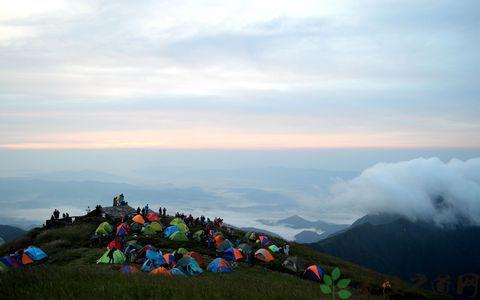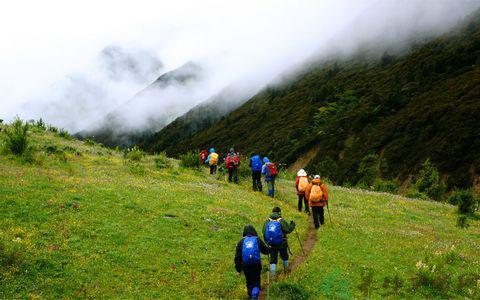Introduction:Hiking is an outdoor activity chosen by many people in spring, which can not only see the beautiful spring scenery, but also exercise and enhance physical fitness. However, long-distance hiking should be well prepared to easily cope with the problems in the middle. So what should I do to prepare for a long hike? Let’s take a look at how to prepare for long-distance hiking.
1. You must start practicing early, at least once a week, and walk for at least 4 to 6 hours (about 15 to 25 kilometers) each time. The practice time and distance should be increased according to the progress, and each practice should include going up the mountain and walking on the rugged mountain path. Players should be free to walk for 10 to 11 hours continuously.
2. Be familiar with the route during the practice, and pay more attention to the sections that pass at night. After sufficient training, choose another weekend for evening practice. In the dark, the sense of distance and direction is different from that in the daytime. Participants should learn how to use flashlights to walk rough mountain paths in the dark.
3. Teams that fail to practice early are advised to have a two-day training session two weeks before they formally participate in the activity, and walk for 8 to 10 hours every day, so as to adapt to long-term walking under the condition of fatigue.

4. Participants who are interested in completing the whole course in the best condition can run slowly for a short distance every day to enhance their physical fitness and endurance.
5. The amount of rest during the activity varies from person to person, but don’t rest for too long, which will harden the sore muscles. You might as well have more rest, but it should not be too long at a time.
6. Before starting and after each rest, do enough warm-up exercises to enhance muscle flexibility.
7. Trim the toenails one week before the activity to reduce the chance of toe injury when going downhill.
8. The weather may change during the activity, so you must bring appropriate clothes. Once the clothes are soaked, they can be replaced immediately.
9. Wear comfortable running shoes or hiking shoes. New shoes are easy to cause foot discomfort and stimulate the formation of blisters. Therefore, when formally participating in activities, it is best to wear shoes worn during practice.
10. Experienced participants suggest applying lubricating cream to feet, wearing two pairs of socks or wrapping toes with medical tape to reduce the chance of blisters.
11. Change socks frequently during activities to help prevent blisters from forming. If blisters have formed, try not to pierce the blisters or cut off the epidermis.
12. Carefully count the items needed for each journey, just bring the necessities. Remember to bring enough water and warm clothes.
13. It’s windy in the mountains at night, and it’s easy to catch cold. You should bring a light windbreaker. In order to avoid getting wet by rain, a raincoat is also a must.
14, in order to avoid heatstroke, remember to bring a sun hat or umbrella, and sunglasses and other sunscreen products.
15. A reliable hiking stick is of great help to walking the mountain trail for a long time.
16. Clear water is the best drink to replenish water, but when your legs are sore and your will is low, it will be very helpful to enjoy sugary drinks, healthy drinks, high-energy snacks or cakes. As for foods high in fat and protein, they should not be eaten.
17. Knee pads and elbow pads help prevent injuries to muscles, ligaments and joints.

18. Experienced hikers suggest that participants bring the following necessities (optional): ID card/passport, cash (appropriate amount), enough clean water, high-calorie food (glucose cake, chocolate), sweat towel, hiking stick, replacement clothes and warm clothes, replacement socks, insoles, blister tape, windbreaker/rain gear, fully charged mobile phone, backup phone battery and paper towels.
19, understand the distance of each section, road conditions. Whether it is cement road, bluestone road or hard dirt road, which places should pay attention to traffic safety and where there are supplies, only by fully understanding these can we have a more reasonable arrangement for the whole trip.
20. It is best to use two pairs of walking shoes or sports shoes with different textures and different insoles in turn. The larger size will be more comfortable to wear at the end. Hiking shoes are heavy and the soles are hard, so hiking shoes are not suitable for long-distance hiking on roads.
21. Long-distance flat crossing will inevitably cause extreme fatigue of the soles of the feet. If you are equipped with two pairs of shoes with different textures and insoles (such as light running shoes, hiking shoes and sports shoes), you can change your shoes every hour and often change your walking mode (combination of walking and trotting), rotate the stress points of the sole of your foot, and mobilize more muscle groups in your legs to participate in sports, which will certainly alleviate fatigue and pain and you can walk a longer distance.
22. If you don’t camp on a long trip, just bring a dirty fleece or cotton sleeping bag liner. For ordinary camping, a general waterproof and wind-resistant tent will do. For long-distance travel, it is recommended to bring a small and light tent.
What preparations should you make for a long hike? The above is the content summarized by Health-keeping Network for your reference.
Source: the way of keeping in good health